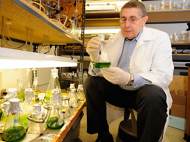Significant biomass increase of genetically altered algae
 One of the efforts to become fossil fuel independent is to use biofuel generated by crops, but it stirred a big debate due to lack of food and fertile ground around the world. Using algae as biofuel can be up to 300 times more efficient than conventional crops, and researcher from the Iowa State University found a genetic method that can improve it even further by increasing algae biomass.
One of the efforts to become fossil fuel independent is to use biofuel generated by crops, but it stirred a big debate due to lack of food and fertile ground around the world. Using algae as biofuel can be up to 300 times more efficient than conventional crops, and researcher from the Iowa State University found a genetic method that can improve it even further by increasing algae biomass.
“The key to this (increase in biomass) is combination of two genes that increases the photosynthetic carbon conversion into organic matter by 50 percent over the wild type under carbon dioxide enrichment conditions”, said Martin Spalding, professor in the Department of Genetics, Development, and Cell Biology.
Algae found in nature are limited from growing faster because they don’t get enough carbon dioxide from the atmosphere. In order to compensate for relatively low levels of carbon dioxide (CO2), LCIA and LCIB genes in algae become expressed (turned on). They enable algae to capture and channel more carbon dioxide from the air into the cells to keep the algae alive and growing.
On the other hand, when algae are in environments with high carbon dioxide levels, the two genes mentioned above are repressed (turned off) because the plant is getting enough carbon dioxide. Iowa State University researcher altered those genes to become expressed during such conditions, thus enabling algae to increase the amount of photosynthesis in the plant and produce more biomass.
“Based on some prior research we had done, we expected to see an increase, probably in the 10 to 20 percent range”, said Spalding. “But we were surprised to see this big of an increase.”
Spalding used Chlamydomonas reinhardtii in separate experiments with LCIA and LCIB expressed, and those methods provided 10 to 15 percent increase in biomass. Surprisingly, once he experimented with the two genes expressed at the same time, the biomass increased by 50 to 80 percent.
“Somehow these two genes are working together to increase the amount of carbon dioxide that’s converted through photosynthesis into biomass by the algae under conditions where you would expect there would already be enough carbon dioxide”, said Spalding.
The excess biomass naturally becomes starch through the photosynthesis process, and increases the starch biomass by around 80 percent. By using some existing mutated genes, algae can be used to produce oil instead of starch, but the process requires more energy and yields “only” 50 percent increase in oil biomass.
Algae have a harvesting cycle of 1 to 10 days, and can be grown on land that is not suitable for other established crops. Just like fossil fuel, harvested algae fuel releases CO2 when burnt. However, emitted CO2 is taken out of the atmosphere by the growing algae and the process is more carbon neutral.
The major obstacle in use of algae biofuel is the high up-front investment and the higher price of the end product. Nevertheless, advances in algae fuel production and harvesting, such as one mentioned in this article, increase viability of algae biofuels. Unless it becomes shadowed by some other power source, algae biofuels are surely going to present a major fossil fuel competitor within next 5 to 10 years.









Algae is a potential biofuel of the future.
Dr.A.Jagadeesh Nellore(AP),India
E-mail: anumakonda.jagadeesh@gmail.com
To learn more about the fast-track commercialization of the algae production industry you may want to check out the National Algae Associatiion.